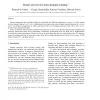Free Online Productivity Tools
i2Speak
i2Symbol
i2OCR
iTex2Img
iWeb2Print
iWeb2Shot
i2Type
iPdf2Split
iPdf2Merge
i2Bopomofo
i2Arabic
i2Style
i2Image
i2PDF
iLatex2Rtf
Sci2ools
115
Voted
CN
1998
1998
Route Servers for Inter-Domain Routing
Internet transmission and switching facilities are partitioned into different administrative domains. To effect routing between domains, domain border routers establish pairwise peering sessions and exchange routing information at exchange points. An alternative arrangement, in which each border router at an exchange point peers only with a Route SerÕer, provides some operational benefits. From a set-theoretic characterization of border router behavior, we derive a set-theoretic expression that completely and succinctly characterizes Route Server functionality. Performance measurements from our Route Server implementation reveal that the storage requirements of Route Servers can be much larger than that of a typical border router. We discuss a variety of techniques that can, in some cases, reduce Route Server storage requirements by a factor of five or more. q 1998 Elsevier Science B.V. All rights reserved.
Border Router | CN 1998 | Route Server | Router |
Related Content
| Added | 21 Dec 2010 |
| Updated | 21 Dec 2010 |
| Type | Journal |
| Year | 1998 |
| Where | CN |
| Authors | Ramesh Govindan, Cengiz Alaettinoglu, Kannan Varadhan, Deborah Estrin |
Comments (0)

